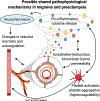Neurology of Preeclampsia and Related Disorders: an Update in Neuro-obstetrics
- PMID: 33825997
- PMCID: PMC10069269
- DOI: 10.1007/s11916-021-00958-z
Neurology of Preeclampsia and Related Disorders: an Update in Neuro-obstetrics
Abstract
Purpose of review: Preeclampsia and related hypertensive disorders of pregnancy affect up to 10% of pregnancies. Neurological complications are common and neurologists often become involved in the care of obstetric patients with preeclampsia. Here, we review the definition(s), epidemiology, clinical features, and pathophysiology of preeclampsia, focusing on maternal neurological complications and headache as a common presenting symptom of preeclampsia.
Recent findings: Neurological symptoms are early and disease-defining features of preeclampsia. Neurological complications of preeclampsia may include headaches, visual symptoms, cerebral edema, seizures, or acute cerebrovascular disorders such as intracerebral hemorrhage or reversible cerebral vasoconstriction syndrome. A history of migraine is an independent risk factor for vascular diseases during pregnancy, including preeclampsia and maternal stroke. The pathophysiology of both preeclampsia and migraine is complex, and the mechanisms linking the two are not fully understood. Overlapping clinical and pathophysiological features of migraine and preeclampsia include inflammation, vascular endothelial dysfunction, and changes in vasoreactivity. Neurological complications are recognized as a major contributor to maternal morbidity and mortality. Pregnant and postpartum women commonly present with headache, and red flags in the clinical history and examination should prompt urgent neuroimaging and laboratory evaluation. A focused headache history should be elicited from patients as part of routine obstetrical care to identify patients at an increased risk of preeclampsia and related hypertensive disorders of pregnancy. Collaborative models of care and scientific investigation in the emerging field of neuro-obstetrics have the common goal of reducing the risk of maternal neurological morbidity and mortality from preeclampsia.
Keywords: Headache; Maternal mortality; Neuro-obstetrics; Preeclampsia; Stroke.
Figures

Similar articles
-
Neurological manifestations and neuroimaging presentations in patients with severe preeclampsia: predisposing factors and clinical implications.Neurol Sci. 2019 Jun;40(6):1245-1253. doi: 10.1007/s10072-019-03833-3. Epub 2019 Mar 19. Neurol Sci. 2019. PMID: 30891638
-
Long-term consequences of the posterior reversible encephalopathy syndrome in eclampsia and preeclampsia: a review of the obstetric and nonobstetric literature.Obstet Gynecol Surv. 2014 May;69(5):287-300. doi: 10.1097/OGX.0000000000000069. Obstet Gynecol Surv. 2014. PMID: 25101694 Review.
-
Eclampsia in the 21st century.Am J Obstet Gynecol. 2022 Feb;226(2S):S1237-S1253. doi: 10.1016/j.ajog.2020.09.037. Epub 2020 Sep 24. Am J Obstet Gynecol. 2022. PMID: 32980358 Review.
-
[Fatal complications in pre-eclampsia and eclampsia].Ceska Gynekol. 2002 Nov;67(6):365-71. Ceska Gynekol. 2002. PMID: 12661377 Czech.
-
Maternal Stroke: an Update.Curr Atheroscler Rep. 2019 Jun 22;21(9):33. doi: 10.1007/s11883-019-0798-2. Curr Atheroscler Rep. 2019. PMID: 31230137 Free PMC article. Review.
Cited by
-
Arnold-Chiari Malformations in Pregnancy and Labor: Challenges and Management Strategies.Cureus. 2023 Aug 18;15(8):e43688. doi: 10.7759/cureus.43688. eCollection 2023 Aug. Cureus. 2023. PMID: 37724202 Free PMC article. Review.
-
Risk factors of intracranial haemorrhage in preeclampsia: a case-control study.Neurol Sci. 2022 Oct;43(10):6003-6010. doi: 10.1007/s10072-022-06286-3. Epub 2022 Jul 23. Neurol Sci. 2022. PMID: 35871180
-
Stroke vs. Preeclampsia: Dangerous Liaisons of Hypertension and Pregnancy.Medicina (Kaunas). 2023 Sep 24;59(10):1707. doi: 10.3390/medicina59101707. Medicina (Kaunas). 2023. PMID: 37893425 Free PMC article. Review.
-
Diagnosis and Treatment of Eclampsia.J Cardiovasc Dev Dis. 2024 Aug 23;11(9):257. doi: 10.3390/jcdd11090257. J Cardiovasc Dev Dis. 2024. PMID: 39330315 Free PMC article. Review.
-
The optic nerve sheath in hypertensive disorders of pregnancy and perinatal outcomes: a cohort study.BMC Pregnancy Childbirth. 2024 Oct 7;24(1):654. doi: 10.1186/s12884-024-06858-5. BMC Pregnancy Childbirth. 2024. PMID: 39375707 Free PMC article.
References
-
- Centers for Disease Control. Data on selected pregnancy complications in the United States. cdc.gov. 2019. Available from: https://www.cdc.gov/reproductivehealth/maternalinfanthealth/pregnancy-co.... Accessed 29 Dec 2020
-
- Centers for Disease Control. Pregnancy mortality surveillance system [Internet]. cdc.gov. Atlanta; Available from: https://www.cdc.gov/reproductivehealth/maternalinfanthealth/pmss.html. Accessed 14 Feb 2019
-
- Say L, Chou D, Gemmill A, Tunçalp Ö, Moller A-B, Daniels J, et al. Global causes of maternal death: a WHO systematic analysis. Lancet Glob Health. 2014;2:e323–33. - PubMed
-
- Hibbard LT. Maternal mortality due to acute toxemia. Obstet Gynecol. 1973;42:263–70. - PubMed
-
- Gibbs CE, Locke WE. Maternal deaths in Texas, 1969 to 1973. A report of 501 consecutive maternal deaths from the Texas Medical Association’s Committee on Maternal Health. Am J Obs Gynecol. 1976;126:687–92. - PubMed
Publication types
MeSH terms
Grants and funding
LinkOut - more resources
Full Text Sources
Other Literature Sources
Medical
Research Materials

